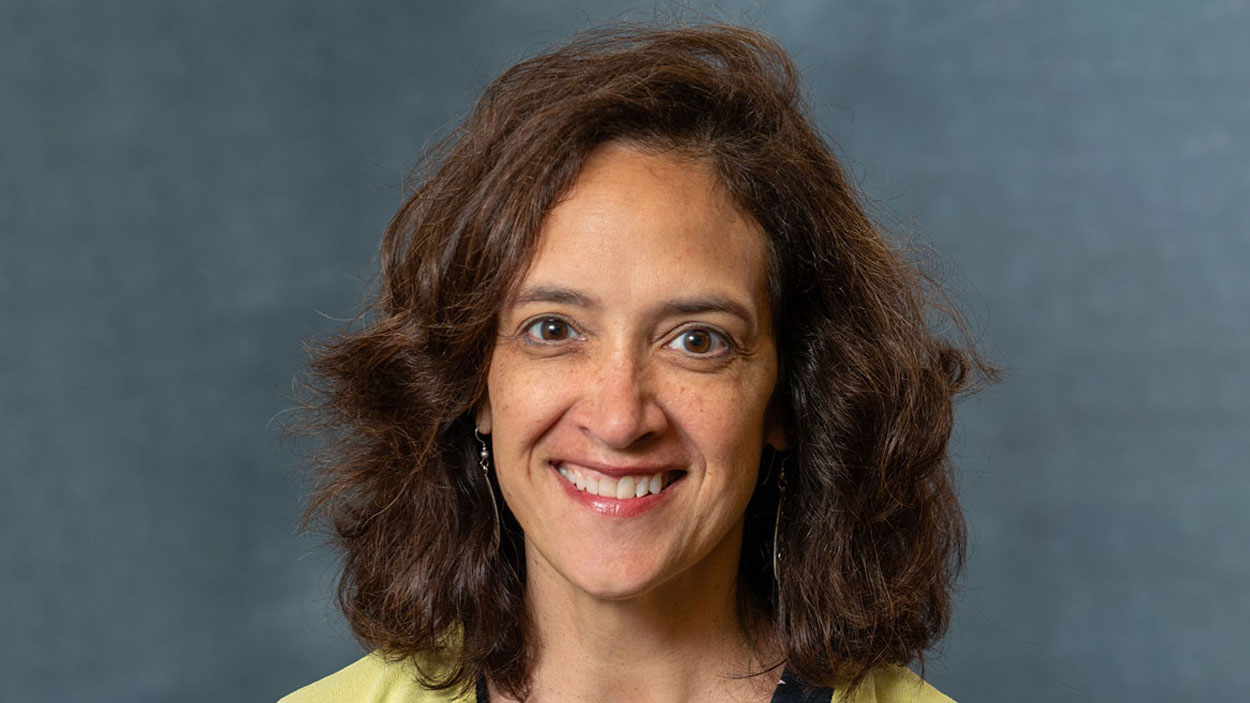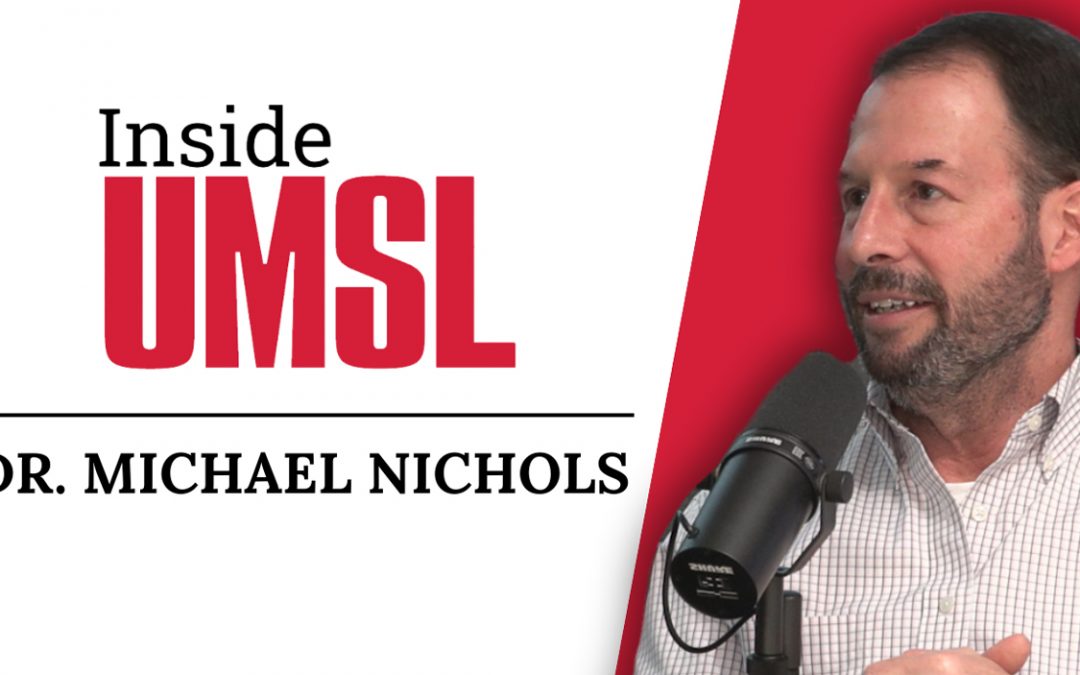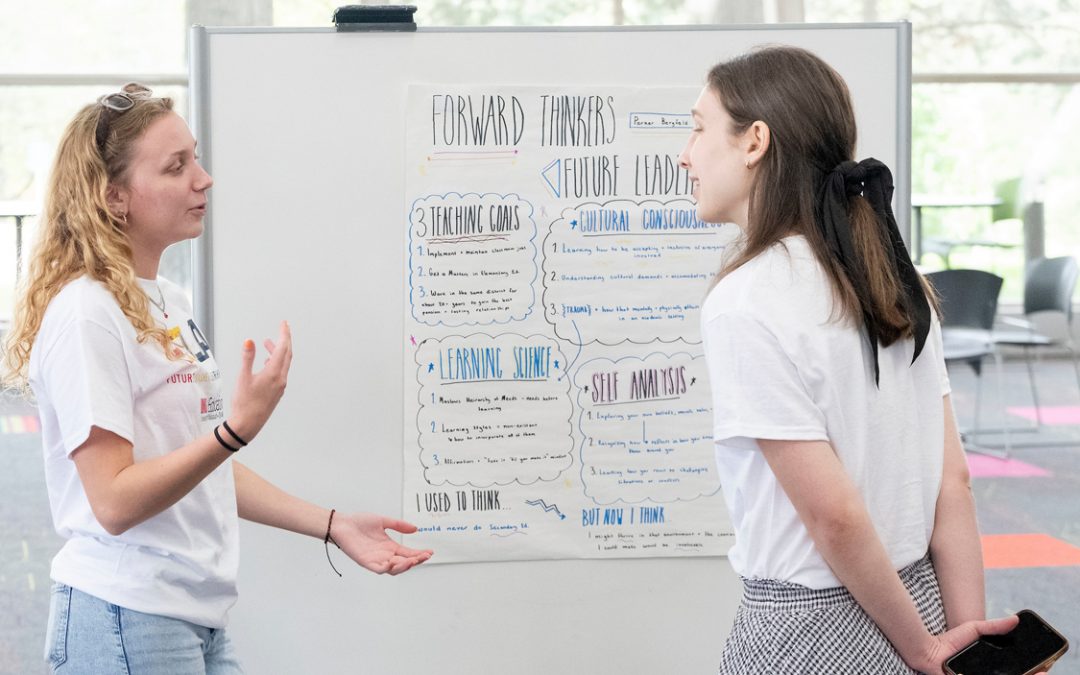
Julie Bertram is an assistant professor in UMSL’s College of Nursing. Her research and clinical work, including the Wrap Around Wellness Program, focuses on the mental health outcomes of children and adolescents in foster care. (Photo by Derik Holtmann)
Studies have shown that children and adolescents in foster care are prescribed psychotropic medications at rates 2 to 3 times higher than other children.
Julie Bertram, an assistant professor in the College of Nursing at the University of Missouri–St. Louis, is well-aware of these staggering statistics, having focused much of her research and clinical work on the mental health outcomes of children and adolescents in foster care.
In collaboration with community partner Children’s Permanency Partnership – a foster care consortium made up of FamilyForward, Youth in Need and Epworth Children & Family Services – Bertram designed the Wrap Around Wellness Program, an evidence-based care coordination program, to meet this challenge and improve wellness outcomes for youth in the foster care system in the St. Louis area.
A shifting interest
Bertram has always been drawn to service and health care and initially thought she’d like to become a doctor. That changed when she was 15, however, and had a spinal fusion for scoliosis. As she was recovering in the hospital, she started to become more interested in nursing – an interest further cemented by a friend’s mom who served as a role model at the time.
Bertram went on to earn her BSN and a master’s degree in psychiatric and mental health nursing from Saint Louis University. For 15 years, she worked as an RN in a hospital setting, specializing in psychiatric mental health. Because of her expertise in psychiatric mental health nursing and her certification in child adolescent psychiatry, in 2008, she was invited to join a research study on treatment in foster care for older youth as a nurse consultant. That proved to be a pivotal moment in her career.
Working alongside J. Curtis McMillen, then an associate professor at Washington University in St. Louis, Bertram began working with youth who were living in institutions and residential settings through the foster care system to help them transition back into the community and build skills for self-sufficiency. She sat in on weekly team meetings, conducted diagnostic and medication reviews and created psychoeducation materials for both the youth and foster parents. After the team’s study was completed, she began training foster parents on medication management and started developing her own dissertation research.
Although she hadn’t initially planned to study the foster care system, she felt the research fit into her larger vision for creating trauma-informed communities.
“The trauma-informed approach to service delivery has wide application,” Bertram said. “Foster care is just one of many systems that can benefit from learning and living out a trauma-informed way of doing the work. Trauma-informed, as an approach, is one that transcends hospital-based nursing care, and it’s not tied to just one setting. I used to think that hospital-based psychiatric-mental health nursing care was the end-all-be-all, but mental health promotion is so much larger. Trauma-informed is an approach across multiple settings, and many service-facing professionals and recipients of care can benefit.”
With her research interest in the role of psychiatric-mental health nursing within the child welfare and foster care system cemented, Bertram then enrolled in UMSL’s College of Education for her PhD in educational leadership and policy studies. For her dissertation on decision-making in the foster care system, she used primarily qualitative methods to evaluate how stakeholders engage in decision-making in the context of family support team meetings. Bertram was able to attend these meetings and observe communication dynamics, interview stakeholders and look at how court hearings are run. She then administered empowerment scales to both the foster care youth and the adults that comprised their teams.
From all of those data sources, Bertram developed a better understanding of how the system works. Although she had some hunches from her previous work, she was able to learn more about different child welfare policies, different structures in place and the issues that make it difficult for families to leave the foster care system.
“Ideally, the child welfare system is communicating and collaborating with the court system, the medical system, the education system and families, but it’s actually not that easy to coordinate and collaborate among all these systems,” Bertram said. “That was part of what I was learning and figuring out: how and why the care might become fragmented. I got a much better appreciation for that from going in the field and seeing the families and hearing the different perspectives of the stakeholders and even the youth themselves.”
Improving wellness outcomes in foster care
Bertram’s dissertation work gave her a deep understanding of how the child welfare system works, including some potential ideas to improve care. As she became known in the community for her work as a nurse consultant, she was invited to join a foster care consortium, the Children’s Permanency Partnership, and started developing research projects in collaboration. In 2017, she joined the faculty in UMSL’s College of Nursing as an assistant professor after holding a similar position at SLU.
Seeking to improve communication and collaboration between the different child welfare systems, Bertram developed the Wrap Around Wellness Program with Alicia Acosta, at the time an MSW student at UMSL who was working as a wellness coordinator for the Children’s Permanency Partnership. Together, the two worked side by side to develop research questions and eventually trademark the program. The goal of the Wrap Around Wellness Program is to improve wellness outcomes for youth in foster care by stimulating collaboration among systems and advancing continuity of care for foster children and youth.
“If anyone would want to learn from us how we were able to implement an effective, all-encompassing wellness program within the foster care organization, they can look at what we’ve developed,” Bertram said. “But we wouldn’t want them to implement it in a piecemeal way; we would want them to implement it according to the fidelity of several mechanisms, patterns, processes, procedures and roles that we developed.”
The program features a 30-hour web-based curriculum with different modules that address trauma awareness, common disorders, how the body works and how different medications work, in addition to trainings featuring a menu of holistic interventions. The program includes different roles, such as a wellness coordinator, quality assurance director, psychiatric nurse and leadership personnel, all with particular responsibilities. The program tracks data, such as medication use and patterns, some of which already must be documented due to state and federal guidelines.
One element unique to the program is the bimonthly residential review meetings between the leadership team, including Bertram and the case managers, and the youth in foster care. She said the meetings inspire accountability because case managers can walk away from the meetings with practical things to do, such as asking the provider for lab tests or requesting an incident report when there are seclusion and restraint episodes.
“The idea is if we convene these meetings and we talk about the status of that young person and what’s happening with their case, we can identify patterns and trends and maybe make recommendations for things that need to be changed,” Bertram said. “The goal is to get the person to move out of that restrictive environment into a lesser level of care.”
Ultimately, they hope the program would lead to permanency, such as a permanent placement with the family of origin, foster family or another adult caregiver, or self-sufficiency, where the young person has aged out of foster care and is able to live successfully on their own.
“As a general rule of thumb, we want people to be able to move out of residential into a situation where they’re able to grow and thrive,” Bertram said.
With that said, Bertram said there’s a need to develop interventions to support transition-age youth with mental health issues so that they are able to advocate for themselves once they leave the foster care system. She has several other possible lines of future research, too, and enjoys getting students in the College of Nursing involved with developing research questions, data analysis and manuscript preparation.
Ideally, Bertram would like to see if the program can be implemented in other parts of the country and sees an opportunity to conduct more research, develop data collection and offer training, resources and support to those working to support youth in foster care in other states. She is also interested in developing new questions and sees possibilities for intersection with a variety of disciplines.
“If you’re interested in trauma-informed approaches or if you’re interested in foster care, you don’t have to be just one kind of person to get involved in those initiatives,” she said. “You could be someone who is interested in social work or nursing or medicine or psychology – there’s so many possibilities. There’s a place for everyone to be involved and think about how they could make a difference.”














